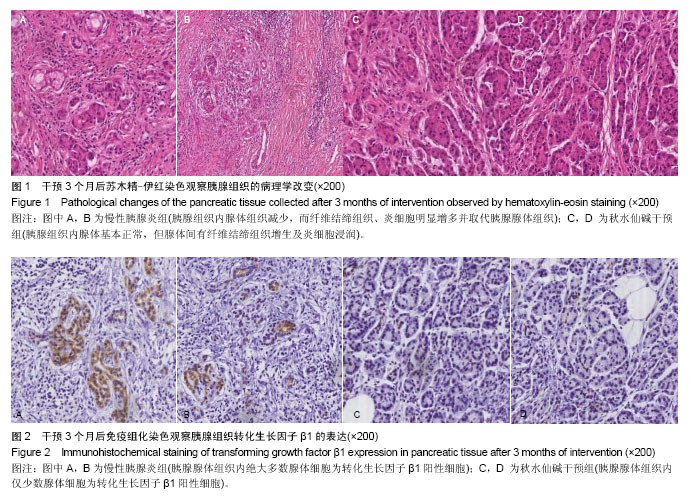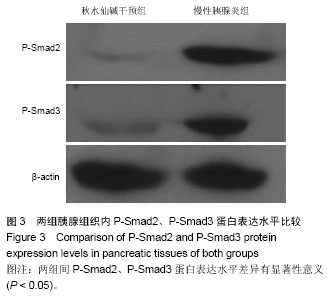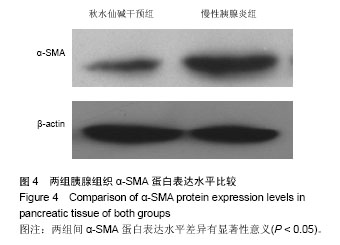| [1] Zhang SK, Cui NQ, Zhuo YZ,et al. Modified Xiaochaihu Decoction prevents the progression of chronic pancreatitis in rats possibly by inhibiting transforming growth factor-β1/Sma- and mad-related proteins signaling pathway.Chin J Integr Med. 2013;19(12):935-939.
[2] Chen JM, Férec C. Genetics and pathogenesis of chronic pancreatitis: the 2012 update.Clin Res Hepatol Gastroenterol. 2012;36(4):334-340.
[3] Chen JM, Férec C.Chronic pancreatitis: genetics and pathogenesis.Annu Rev Genomics Hum Genet. 2009;10: 63-87.
[4] Inui K, Yoshino J, Miyoshi H,et al.New developments in diagnosis and non-surgical treatment of chronic pancreatitis.J Gastroenterol Hepatol. 2013;28 Suppl 4:108-112.
[5] Rebibo L,Yzet T, Cosse C,et al. Frey procedure for the treatment of chronic pancreatitis associated with common bile duct stricture.Hepatobiliary Pancreat Dis Int. 2013;12(6): 637-644.
[6] 王洛伟,李兆申.慢性胰腺炎研究进展[J].世界华人消化杂志, 2007,15(34):3598-3603.
[7] 闫晶晶,崔乃强.慢性胰腺炎胰腺纤维化发病机制及其治疗的研究进展[J].中华肝胆外科杂志,2007,13(6):422-424.
[8] 王兴鹏,张汝玲.慢性胰腺炎的病因和发病机制[J].中国实用外科杂志,2011,31(9):778-780.
[9] 狄扬,傅德良.慢性胰腺炎胰腺纤维化发病机制的研究进展[J].中国实用外科杂志,2011,31(9):826-829.
[10] 郑振江,向光明,刘续宝.胰腺星状细胞在胰腺纤维化中的作用[J].中国普外基础与临床杂志, 2010,17(8):876-879.
[11] 范昕,王莹,侯雯跻,等.小鼠胰腺星状细胞的分离培养与鉴定[J].江苏大学学报:医学版,2012,22(6):468-471.
[12] 陈启龙,李国威,陈晓,等.转化生长因子β1在胰腺组织中的表达:慢性胰腺炎发病机制探讨[J].中国普通外科杂志,2002,11(10): 612-615.
[13] 王东盛,刘倩.己酮可可碱对大鼠胰腺纤维化及TGF-β1、α-SMA、MMP-1、TIMP-1表达的影响[J].中国现代普通外科进展,2006, 9(4):222-224.
[14] 何少武,胡先贵,金钢,等. TGF-β1和α-SMA在慢性胰腺炎组织中的表达及意义[J].第二军医大学学报,2003,24(11):1215-1218.
[15] Gu H, Mickler EA, Cummings OW,et al. Crosstalk between TGF-β1 and complement activation augments epithelial injury in pulmonary fibrosis.FASEB J. 2014. [Epub ahead of print].
[16] Kinashi H, Ito Y, Mizuno M,et al.TGF-β1 promotes lymphangiogenesis during peritoneal fibrosis.J Am Soc Nephrol. 2013;24(10):1627-1642.
[17] Pang L, Wei C, Duan J,et al.TGF-β1/Smad signaling, MMP-14, and MSC markers in arterial injury: discovery of the molecular basis of restenosis.Int J Clin Exp Pathol. 2014; 7(6):2915-2924.
[18] Yu C, Liu Y, Huang D,et al.TGF-β1 mediates epithelial to mesenchymal transition via the TGF-β/Smad pathway in squamous cell carcinoma of the head and neck.Oncol Rep. 2011;25(6):1581-1587.
[19] Fang L, Chang HM, Cheng JC,et al.TGF-β1 induces COX-2 expression and PGE2 production in human granulosa cells through Smad signaling pathways.J Clin Endocrinol Metab. 2014;99(7):E1217-1226.
[20] Zhou F, Li GY, Gao ZZ,et al.The TGF-β1/Smad/CTGF pathway and corpus cavernosum fibrous-muscular alterations in rats with streptozotocin-induced diabetes.J Androl. 2012; 33(4):651-659.
[21] Pan MM, Zhang MH, Ni HF,et al. Inhibition of TGF-β1/Smad signal pathway is involved in the effect of Cordyceps sinensis against renal fibrosis in 5/6 nephrectomy rats.Food Chem Toxicol. 2013;58:487-494.
[22] Gao Y, Lui WY.Transforming growth factor-β1 (TGF-β1) regulates cell junction restructuring via Smad-mediated repression and clathrin-mediated endocytosis of nectin-like molecule 2 (Necl-2).PLoS One. 2013;8(5):e64316.
[23] Lo GH, Perng DS, Chang CY,et al.Controlled trial of ligation plus vasoconstrictor versus proton pump inhibitor in the control of acute esophageal variceal bleeding.J Gastroenterol Hepatol. 2013;28(4):684-689.
[24] Tasci I, Deveci S, Isik AT,et al. Allopurinol in rat chronic pancreatitis: effects on pancreatic stellate cell activation. Pancreas. 2007;35(4):366-371.
[25] Ozdemir O, Calisaneller T, Sonmez E,et al.Topical use of colchicine to prevent spinal epidural fibrosis in rats.Neurol Res. 2010;32(10):1117-1120.
[26] Ozdemir BH, Ozdemir FN, Sezer S,et al. Does colchicine have an antifibrotic effect on development of interstitial fibrosis in renal allografts of recipients with familial Mediterranean fever.Transplant Proc. 2006;38(2):473-476.
[27] Nikolaidis N, Kountouras J, Giouleme O,et al. Colchicine treatment of liver fibrosis.Hepatogastroenterology. 2006; 53(68):281-285.
[28] D'Haese JG, Ceyhan GO, Demir IE,et al.Treatment options in painful chronic pancreatitis: a systematic review.HPB (Oxford). 2014;16(6):512-521.
[29] Apte MV, Pirola RC, Wilson JS. Battle-scarred pancreas: role of alcohol and pancreatic stellate cells in pancreatic fibrosis.J Gastroenterol Hepatol. 2006;21 Suppl 3:S97-S101.
[30] Cocco G, Chu DC, Pandolfi S.Colchicine in clinical medicine. A guide for internists.Eur J Intern Med. 2010;21(6):503-508.
[31] Poloz Y, O'Day DH.Colchicine affects cell motility, pattern formation and stalk cell differentiation in Dictyostelium by altering calcium signaling.Differentiation. 2012;83(4):185-199.
[32] Tseng CY, Mane JY, Winter P,et al.Quantitative analysis of the effect of tubulin isotype expression on sensitivity of cancer cell lines to a set of novel colchicine derivatives.Mol Cancer. 2010;9:131.
[33] 孙嘉临,王先化.秋水仙碱对实验性大鼠肝纤维化的影响[J].中国现代医生,2012, 50(14): 1-2.
[34] Massagué J, Wotton D.Transcriptional control by the TGF-beta/ Smad signaling system.EMBO J. 2000;19(8): 1745-1754.
[35] Lin Y, Zhang B, Liang H,et al. JNK inhibitor SP600125 enhances TGF-β-induced apoptosis of RBE human cholangiocarcinoma cells in a Smad-dependent manner.Mol Med Rep. 2013;8(6):1623-1629.
[36] Karathanasi V, Tosios KI, Nikitakis NG,et al.TGF-β1, Smad-2/-3, Smad-1/-5/-8, and Smad-4 signaling factors are expressed in ameloblastomas, adenomatoid odontogenic tumors, and calcifying cystic odontogenic tumors: an immunohistochemical study.J Oral Pathol Med. 2013;42(5): 415-423.
[37] Heldin CH, Miyazono K, ten Dijke P.TGF-beta signalling from cell membrane to nucleus through SMAD proteins.Nature. 1997;390(6659):465-471.
[38] 陆宏伟,袁甫军,单涛,等.秋水仙碱通过阻滞TGF-β1/Smads通路抑制胰腺星状细胞生物学行为的研究[J].中国现代普通外科进展, 2014,17(4):258-262. |



.jpg)